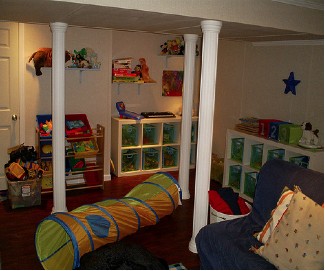In many homes, the basement is a good location for a playroom, but there is a lot more to making it kid-friendly than tossing down a soft carpet and telling the kids to stay away from the power tools. For the basement play environment your kids deserve, here are 10 things to consider.

1. Building codes
Codes are not fun but they are important to health and safety. My recommendation is to read them before beginning any remodeling project, including a basement remodel. They will give you lots of pertinent information about minimums for room size, ceiling height, glazed areas, open-able glazed areas, stair treads and risers, and emergency escape and rescue openings’ height and area. It also spells out requirements for wiring, plumbing, smoke and CO alarms, and much more. Go to http://ow.ly/lHMb9 for a free online copy of the codes.
2. Layout
You will probably not be devoting your entire basement to building a playroom. Some of it will undoubtedly be reserved for utilities, the laundry, general storage, and perhaps a workshop. Plan the layout so the play area is closest to the foot of the stairs. That way kids won’t have to walk through other areas to enter or exit the playroom. If an area is devoted to woodworking or hobbies, it should have a lockable door to prevent kids from experimenting with tools without supervision. If it’s not possible to have a lockable door, store hazardous tools and supplies in locked cabinets.
3. Climate and air quality control
Kids don’t like musty smells, dampness, or chilly air any more than you do. If your basement is uncomfortable or unpleasant, do all the things necessary to change it. For many basements, your checklist will include drains and sump pumps, foundation wall insulation, and heating. In addition, including a high-capacity dehumidifier is especially important because high humidity encourages the growth of mold and the dispersion of mold spores, a common cause of allergies and asthma.

4. Storage
A toy chest has to be one of the most frustrating storage devices ever invented. You wouldn’t put your kitchen cookware in one. Don’t expect your kids to keep their toys organized in one either. Open cubbies and shelves, no more than a few feet tall, are much better. For older children, you can add drawers, higher shelving, and freestanding closets, as required. Just make sure to use the anti-tipping hardware supplied by the furniture makers for tall storage units or to install your own.
5. Furnishings
In addition to storage, include work tables, desks, chairs, easels, and comfortable seating in which to curl up with a book or watch a movie. Stain-resistant or removable and washable upholstery will also make your life easier. The idea is to encourage a variety of activities, from building with construction toys to board games to drawing or painting. Don’t allow the TV to dominate the room or it will dominate your child’s free time, too. Move it to a corner or keep it out of the playroom all together.

6. Lighting
Lighting is essential to a basement, especially one that only has a few small windows. Use a combination of recessed or fluorescent fixtures in the ceiling and table lamps. When possible, enlarge at least one small window to facilitate escape in emergency. This is typically done by adding a window that opens to a window well.
7. Floors
Modular vinyl tiles are a good flooring surface and are available in faux plank, faux parquet, and faux ceramic tile, and carpeted styles. They offer a thermal break between the slab and your kids, making them your warmest option. Put area rugs and large cushions in areas where kids may play or lounge.
8. Walls
Sponge-able walls, trim, and ceiling tiles will make cleanup from spills and splashes quicker and easier. Some waterproof wall panels are pre-finished with a textured, vinyl “skin.” They are resistant to punctures and dents, and washable. Wood panels are also durable and damage resistant but are expensive and will eventually need to be repainted.
9. Ceilings
Even ceilings may take some abuse in a basement playroom. Pool cues, indoor ball games, tape from party decorations, science experiments, and a lot of things an adult could never anticipate can all cause damage. Choose ceiling tiles that will stand up to the action and won’t sag with humidity. And keep a few extra tiles on hand in case of an accident!
10. Sink
If your kids are into working with paint, clay, plaster, glue, or anything else that can get really messy, plan a spot for a sink in your playroom design. It will help keep those messy brushes—and sticky little fingers—out of the kitchen or upstairs bathroom. It should have at least a few feet of countertop beside it. Install it at a height kids can reach when small or supply a sturdy, no-slip stool.
Joe Provey is a freelance writer who lives in Bridgeport, CT. He has worked for publications such as Popular Mechanics, House Beautiful, and The Family Handyman.

